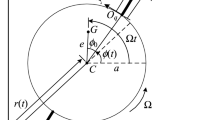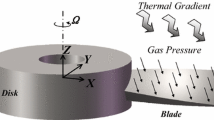Abstract
In this paper, the coupled bending–bending–axial–torsional free vibrations of rotating blades are investigated based on the Euler–Bernoulli beam model. The coupled partial differential equations governing flapwise, edgewise, axial and torsional motions are derived by the Hamilton’s principle, wherein three types of velocity-dependent terms, namely static centrifugal terms, dynamic centrifugal terms and gyroscopic coupling terms, are focused. The ordinary differential equations are acquired by the Galerkin truncation, and the natural frequencies in all directions and complex mode shapes of the rotating blades are analyzed in detail. It is revealed that the three types of velocity-dependent terms have different effects on the natural frequencies. The natural frequencies are noticeably dependent on the rotating speed and preset angle, except for the axial vibration, which is almost immune to the preset angle. The complex modal motions are displayed by a series of positions of the central line and free-end cross section for different time instants, showing the coupled vibrations among different directions.







Similar content being viewed by others
References
Hodges DH. A mixed variational formulation based on exact intrinsic equations for dynamics of moving beams. Int J Solids Struct. 1990;26:1253–73.
Cesnik CES, Shin SJ, Wilbur ML. Dynamic response of active twist rotor blades. Smart Mater Struct. 2001;10:62–76.
Bendiksen OO, Friedmann PP. The effect of bending-torsion coupling on fan and compressor blade flutter. ASME J Eng Power. 1982;104:617–23.
Cesnik CES, Hodges DH. VABS: A new concept for composite rotor blade cross-sectional modeling. J Am Helicopter Soc. 1997;42:27–38.
Wright AD, Smith CE, Thresher RW, Wang JLC. Vibration modes of centrifugally stiffened beams. ASME J Appl Mech. 1982;49:197–202.
Naguleswaran S. Lateral vibration of a centrifugally tensioned uniform Euler–Bernoulli beam. J Sound Vib. 1994;176:613–24.
Du H, Lim MK, Liew KM. A power-series solution for vibration of a rotating Timoshenko beam. J Sound Vib. 1994;175:505–23.
Sanchezhubert J, Sanchezpalencia E. Coupling of bending-torsion-traction for anisotropic beams with heterogeneous section. Cr Acad Sci Ii. 1991;312:337–44.
Banerjee JR. Free vibration of centrifugally stiffened uniform and tapered beams using the dynamic stiffness method. J Sound Vib. 2000;233:857–75.
Chen WR, Keer LM. Transverse vibrations of a rotating twisted Timoshenko beam under axial loading. ASME J Vib Acoust. 1993;115:285–94.
Genta G, Tonoli A. A harmonic finite element for the analysis of flexural, torsional and axial rotordynamic behavior of blade arrays. J Sound Vib. 1997;207:693–720.
Sivaneri NT, Chopra I. Dynamic stability of a rotor blade using finite-element analysis. AIAA J. 1982;20:716–23.
Yang XD, Liu M, Qian YJ, Yang S, Zhang W. Linear and nonlinear modal analysis of the axially moving continua based on the invariant manifold method. Acta Mech. 2017;228:465–74.
Lin SC, Hsiao KM. Vibration analysis of a rotating Timoshenko beam. J Sound Vib. 2001;240:303–22.
Lee SY, Sheu JJ. Free vibrations of a rotating inclined beam. ASME J Appl Mech. 2007;74:406–14.
Banerjee JR, Kennedy D. Dynamic stiffness method for inplane free vibration of rotating beams including Coriolis effects. J Sound Vib. 2014;333:7299–312.
Chung J, Yoo HH. Dynamic analysis of a rotating cantilever beam by using the finite element method. J Sound Vib. 2002;249:147–64.
Kim H, Yoo HH, Chung J. Dynamic model for free vibration and response analysis of rotating beams. J Sound Vib. 2013;332:5917–28.
Pesheck E, Pierre C, Shaw SW. Accurate reduced-order models for a simple rotor blade model using nonlinear normal modes. Math Comput Model. 2001;33:1085–97.
Huang CL, Lin WY, Hsiao KM. Free vibration analysis of rotating Euler beams at high angular velocity. Comput Struct. 2010;88:991–1001.
Huo YL, Wang ZM. Dynamic analysis of a rotating double-tapered cantilever Timoshenko beam. Arch Appl Mech. 2016;86:1147–61.
Li L, Zhang X, Li Y. Analysis of coupled vibration characteristics of wind turbine blade based on Green’s functions. Acta Mech Solida Sin. 2016;29:620–30.
Invernizzi D, Dozio L. A fully consistent linearized model for vibration analysis of rotating beams in the framework of geometrically exact theory. J Sound Vib. 2016;370:351–71.
Kambampati S, Ganguli R. Nonrotating beams isospectral to tapered rotating beams. AIAA J. 2016;54:750–7.
Acknowledgements
This work was supported in part by the National Natural Science Foundation of China (Project Nos. 11672007, 11672189), the Key Laboratory of Vibration and Control of Aero-Propulsion System Ministry of Education, Northeastern University (VCAME201601) and Beijing Natural Science Foundation (Project No. 3172003).
Author information
Authors and Affiliations
Corresponding authors
Ethics declarations
Conflict of interest
The authors declare that they have no conflict of interest.
Rights and permissions
About this article
Cite this article
Liang, F., Li, Z., Yang, XD. et al. Coupled Bending–Bending–Axial–Torsional Vibrations of Rotating Blades. Acta Mech. Solida Sin. 32, 326–338 (2019). https://doi.org/10.1007/s10338-019-00075-w
Received:
Revised:
Accepted:
Published:
Issue Date:
DOI: https://doi.org/10.1007/s10338-019-00075-w




